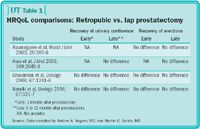Article
Prostate cancer treatments: Assessing effects on quality of life
Author(s):
The most instructive HRQoL studies are those that rely on prospective, longitudinal assessments of patients using a validated instrument.

Analogous instruments for measuring prostate cancer outcomes include the UCLA Prostate Cancer Index (UCLA-PCI), the European Organization for Research and Treatment of Cancer Quality of Life Questionnaire (EORTC-QLQ), and the Expanded Prostate Cancer Index-Composite (EPIC), a validated version of the UCLA-PCI, among others. These instruments allow reliable measurement of patients' urinary, sexual, bowel/rectal and, in the case of EPIC, hormonal side effects of prostate cancer treatment. As such, they can discriminate treatment-related side effects between patients and/or measure change over time in a single patient.

Current instruments for measuring treatment outcomes consist of a series of questions (items) covering topics (domains) that can be either general or disease-specific. After development, instruments are validated to demonstrate that the results are reproducible and that they measure what they are intended to measure.

Equally as important is the administration of questionnaires by unbiased third parties. Comparing HRQoL outcomes from one study with those of another is not valid, due to selection bias, and should be discouraged. However, comparing results between different treatment groups within specific studies, using defined instruments that are administered consistently and defined criteria for including or excluding patients, can provide clinically useful insight regarding prostate cancer treatment outcome expectations.

Comparing lap, open RP outcomes
Although the notion has been broadly advertised in lay media that laparoscopic (or robotic) prostatectomy is associated with faster recovery than is open retropubic surgery, the availability of data supporting such an advantage in the urinary or sexual functional recovery is sparse. Fortunately, there has been an increased awareness of the importance of HRQoL outcomes and, therefore, there is now an accumulating body of evidence that HRQoL outcomes after laparoscopic prostatectomy are likely equivalent to those after retropubic prostatectomy (table 1) in traditionally evaluated HRQoL domains, such as urinary and sexual outcome. At the same time, the minimally invasive approaches may have advantages with regard to postoperative pain, incisional cosmesis, and other incision-related concerns. (These HRQoL domains are the subject of ongoing studies.)















